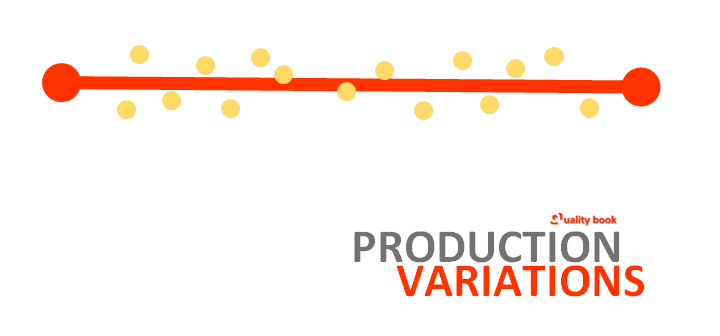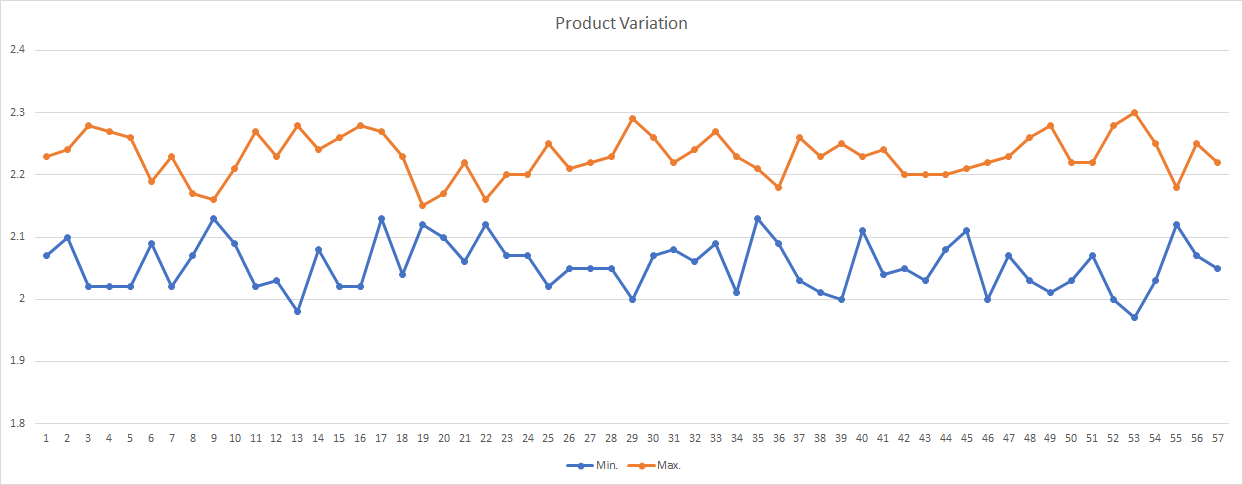How Production Variations impact efficiency, reliability, and profitability. Learn data-driven methods to identify and reduce output fluctuations.
Production quantities always vary. Production personnel always optimistically expect lost production will be recovered before the “end or the week…end of the month…end of the year”–and they rarely do overcome the obstacles which result in a case of sending too much gross margin dollars to corporate headquarters. Consequently, production volumes are always varying.

Production variations raise many questions such as:
1) What is “normal” production output?
2) How do we determine when production failures have occurred?
3) What is the probability that we will meet or exceed the best one-day record?
4) How much production was lost during the year from cutbacks in output?
Failure definition is important. Shewhart control charts often display failure trends. However, control charts often miss information concerning failure modes. Knowing the failure mode (or where different failure modes are occurring) is important information for helping ferret out the root cause of the failure–not all failures are of equal impact.
The Problem
Look at last year’s daily production output described in tons per day from a continuous processing plant where the production is “sold out”, and every ton is needed for meeting customer demand. The data is shown in a frequency table format with tonnage * occurrence.
Daily Production Output (tons) | |||||
| 0.1*5 10*2 25*2 50*2 75*2 100*3 175*1 200*1 | 250*1 300*1 350*1 375*1 400*1 425*1 450*1 475*1 | 500*1 525*1 550*1 575*1 600*2 650*8 675*6 700*9 | 725*8 750*9 775*11 800*21 825*17 850*15 875-15 900*28 | 925*10 850*15 975*9 1000*22 1025*13 1050*17 1075*12 1100*18 | 1125*20 1175*21 1225*17 1275*4 1325*4 1350*3 1450*1 |
| Mean = 897.48, Standard Deviation. = 254.69; Median = 925; Mode = 900 | |||||
Notice the traditional measures of central tendency (Mean = average, Mode = the largest number of observed data points, and Median = half of the data points lie each side) have considerable variance and give a clue that the data is not bell-shaped and symmetrical.
Questions:
1) What information does the data provide about failure modes and how many failure modes exist for this model?
2) What is the normal range of production?
3) Where do typical cutbacks begin?
4) Where do severe cutbacks begin?
5) The data shows the best one-day production input is 1450 tons, what is the probability the process will meet or exceed this best one day production record?
6) How much production was lost during the year from cutbacks in output?
Solutions:
#1: What information does the data provide about failure modes and how many failures modes exist for this model?

Reliability experts, who are purist, will be offended by using a Weibull probability plot for anything but age-to failure data. However, a probability plot of production quantities shows departures from the straight line expected for normal production. The breaks in the curve from the desired trend rate represent “failures” to achieve the desired production rate–clearly these are economic failures caused by either people, processes, procedures, or equipment (or combinations of these categories)!
The data shows three trend lines (maybe two if you’re real fussy).
The steepest curve is the normal production line for about 90.78% of the data. This slope has a b = 5.5 suggest the process has an undesirable coefficient of variation. This is a troubled process because of the flat slope! It has many opportunities for improvement by reducing hidden factory losses from efficiency and utilization losses explained for the nameplate ratings.
Data Trend
The middle slope shows production cutbacks in output (a fairly common failure mode for about 3.6% of the data lying between 90.78% and 94.34% which covers the production range of 350 to 650 tons).
The flattest slope shows the “crash and burn” of major calamities covering about 5.66% of the data.
In short, the data shows two predominate failure modes which degrade ~10% of the production capability. So, the process shows about ~90% reliability and about ~10% unreliability. Now since the data is not shown in age-to-failure format, do not attempt to infer specific modes of failure in the usual manner for Weibull plots.
The breaks in the trend lines tell you to look for different reasons for the failures. By the way, the five production values at 0.1 tons/ per day were actually recorded as zero output. Since you can’t plot zeros on a log scale, enter a small value which is say ~2 logs lower than the smallest real number to reflect an almost zero condition.
#2: What is the normal range of production?
most (99.9%-0.1% = 99.8%) of the expected production will lie between 284 tons/day and 1421 tons per day.
#3: Where do typical cutbacks begin?
Typical cutbacks occur at 650 tons and below. Until the reasons for failure are permanently removed, a watch should be established to flag reasons for the low production and root cause analysis should be initiated to eliminate the problems.
#4: Where do severe cutbacks begin?
Severe crash and burn problems occur at 350 tons and below. Use the same logic as described in the answer of question 3.
#5: The data shows the best one-day production input is 1450 tons, what is the probability the process will meet or exceed this best one day production record?
The normal production trend line projects the probability of achieving production at 1450 tons or more is 0.04%. That’s the same as saying 99.96% chance of not making this production level unless a substantial change has been made to the process which causes a new and higher level of production to be achieved–you’ve got to make a change to get a change! New one day records (such as 1450 tons) are used by production management as carrots for production personnel to run faster and harder–that’s a noble reason but not a realistic reason unless process changes occur to reproduce the results by cause rather than by chance.
#6: How much production was lost during the year from cutbacks in output?
The shaded area between the curves shown in Figure 1 represents the losses. Had the process been in control, losses of 10,183 tons (more than 10 days of lost production) would not have occurred as shown in the table below. In most commodity businesses, profits only occur squeezing the last 10 to 15% out of the output!!
The losses are found by subtracting the predicted normal production curve from the actual data points at the specified % of occurrences are easily obtained from Win SMITH Weibull.
Notice the differences in losses between the “normal” cutback zone losses of 1,397 tons and the severe cut back zone losses of 8,786 tons. On a Pareto distribution basis, correcting the severe cutback zone is the first order of business!
For this case, it emphasizes that arguing about whether cutbacks begin at 650 or 350 or 284 tons is not so important as correcting the primary problem from the severe crash & burn zone. Note that the severe cutback zone’s loss of 8.8 days of production suffers from the five down days–this emphasizes why total down days for turnarounds and other major problems are genuine killers!
Table : #1
| Cutback zone | Severe Cutback zone | |||||
| Normal | Actual | Loss | Normal | Actual | Loss | |
| 650 646 642 638 634 630 625 621 616 611 607 602 7522 | 650 600 600 575 550 525 500 475 450 425 400 375 Total | 0 46 42 63 84 105 125 146 166 186 207 227 1397 | 596 591 585 579 573 567 559 552 544 536 527 518 508 497 484 470 453 434 410 377 321 10681 | 350 300 250 200 175 100 100 100 75 75 50 50 25 25 10 10 .1 .1 .1 .1 .1 Total | 246 291 335 379 398 467 459 452 469 461 477 468 483 472 474 460 453 434 410 377 321 8786 | |
| Cutback Zone = ~1.4 days lost, Severe Cutback Zone = ~8.8 days lost | ||||||
Show less
By the way, how much production can you afford to lose from your process because of partial or total failures? Are your cutback percentages higher or lower than this example?
Comments:
Know your actual production variations and what is possible based on demonstrated results. Identify your failures and find ways to defeat Mr. Murphy and his saboteurs. Keep plants running to generate gross margins. Plants are built to make money–not to sit idle when failures are preventable or controllable.
- Coefficient of Variation
- Nameplate Capacity
- Production Reliability Example with Nameplate Ratings
- Key Performance Indicators from Weibull Production Plots
- Process Reliability Plots with Flat Line Slopes
- Process Reliability Line Segments
- Papers On Process Reliability as PDF Files for No-charge Downloads